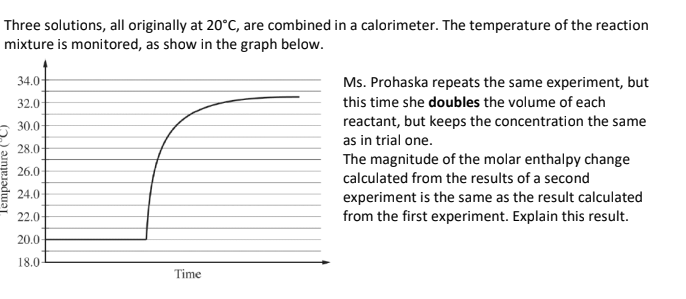Three solutions, all originally at 20°C, are combined in a calorimeter. The temperature of the reaction mixture is monitored, as show in the graph below. 34.0- 32.0 30.0 28.0- 26.0- 24.0 22.0- 20.0 18.0 Time Ms. Prohaska repeats the same experiment, but this time she doubles the volume of each reactant, but keeps the concentration the same as in trial one. The magnitude of the molar enthalpy change calculated from the results of a second experiment is the same as the result calculated from the first experiment. Explain this result.
Three solutions, all originally at 20°C, are combined in a calorimeter. The temperature of the reaction mixture is monitored, as show in the graph below. 34.0- 32.0 30.0 28.0- 26.0- 24.0 22.0- 20.0 18.0 Time Ms. Prohaska repeats the same experiment, but this time she doubles the volume of each reactant, but keeps the concentration the same as in trial one. The magnitude of the molar enthalpy change calculated from the results of a second experiment is the same as the result calculated from the first experiment. Explain this result.
Chapter13: Chemical Equilibrium
Section: Chapter Questions
Problem 10RQ: The only stress (change) that also changes the value of K is a change in temperature. For an...
Related questions
Question
explain the answer using the hess's law (gr 13) please type if possible

Transcribed Image Text:Three solutions, all originally at 20°C, are combined in a calorimeter. The temperature of the reaction
mixture is monitored, as show in the graph below.
Temperature (°C)
34.0-
32.0-
30.0-
28.0-
26.0-
24.0-
22.0-
20.0-
18.0
Time
Ms. Prohaska repeats the same experiment, but
this time she doubles the volume of each
reactant, but keeps the concentration the same
as in trial one.
The magnitude of the molar enthalpy change
calculated from the results of a second
experiment is the same as the result calculated
from the first experiment. Explain this result.
Expert Solution
This question has been solved!
Explore an expertly crafted, step-by-step solution for a thorough understanding of key concepts.
Step by step
Solved in 4 steps with 6 images

Knowledge Booster
Learn more about
Need a deep-dive on the concept behind this application? Look no further. Learn more about this topic, chemistry and related others by exploring similar questions and additional content below.Recommended textbooks for you


Chemistry
Chemistry
ISBN:
9781305957404
Author:
Steven S. Zumdahl, Susan A. Zumdahl, Donald J. DeCoste
Publisher:
Cengage Learning

Chemistry: An Atoms First Approach
Chemistry
ISBN:
9781305079243
Author:
Steven S. Zumdahl, Susan A. Zumdahl
Publisher:
Cengage Learning


Chemistry
Chemistry
ISBN:
9781305957404
Author:
Steven S. Zumdahl, Susan A. Zumdahl, Donald J. DeCoste
Publisher:
Cengage Learning

Chemistry: An Atoms First Approach
Chemistry
ISBN:
9781305079243
Author:
Steven S. Zumdahl, Susan A. Zumdahl
Publisher:
Cengage Learning

Chemistry: The Molecular Science
Chemistry
ISBN:
9781285199047
Author:
John W. Moore, Conrad L. Stanitski
Publisher:
Cengage Learning

Principles of Modern Chemistry
Chemistry
ISBN:
9781305079113
Author:
David W. Oxtoby, H. Pat Gillis, Laurie J. Butler
Publisher:
Cengage Learning

World of Chemistry, 3rd edition
Chemistry
ISBN:
9781133109655
Author:
Steven S. Zumdahl, Susan L. Zumdahl, Donald J. DeCoste
Publisher:
Brooks / Cole / Cengage Learning